Finding water for endangered salmon and cattle in the Sawtooth Valley – A conservation success story
It’s mid-September, and endangered Chinook salmon are heading up to the headwaters of the Salmon River to spawn a new generation.
Thanks to a major collaborative project on Pole Creek, the stream is ready for adult and juvenile fish to thrive.
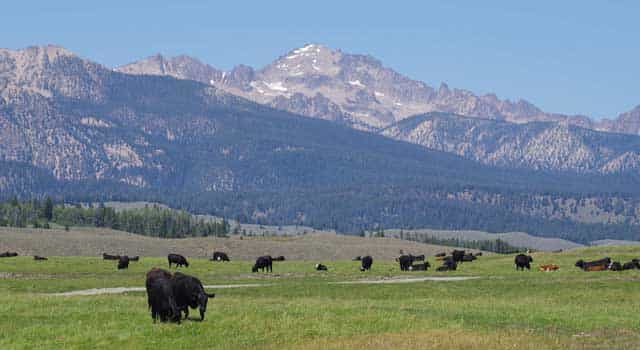
The Henslee family has pastured their cattle in the Sawtooth Valley since the 1930s. The cattle put on 3 pounds a day while grazing on irrigated pastures in an idyllic setting. Below, the new fish-friendly irrigation diverison on Pole Creek.
“Fish and Game is delighted with how this turned out,” said Windy Davis, staff biologist for the Idaho Department of Fish and Game, Salmon Region.
“The Pole Creek project and all of our restorations up here are like welcoming our fish home, back to Idaho. We don’t have a lot of control over how many fish come back but what we can do is leave the light on for them, open the doors, put out the welcome mat, and make it the best place to return home to.”
Rancher Mike Henslee is feeling good about the project after more than seven years of meetings, rigorous environmental review, and then project implementation and construction. Henslee runs the Salmon Falls Ranch, based in Hagerman, with his brother, Mark. Their cattle and sheep grazing operations stretch from the Bruneau Desert to the Sawtooth Valley.
“Right now, everything seems real good. Today’s flow is 20cfs in the creek, and the well is on,” Henslee says. “We’re right in the balancing act. So far, so good. The grass is green, cattle is doing good, as long as all the partners that came together, stay together, we’ll be good.”
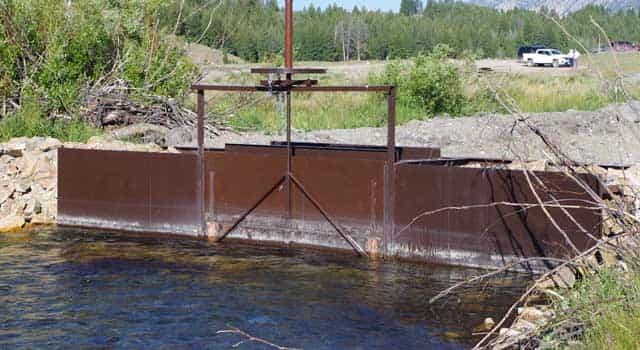
The big challenge was to find more in-stream flows for fish in Pole Creek while providing a sustainable flow to Henslee’s ranch. Their cattle graze on about 1,000 acres of high-quality irrigated pasture adjacent to the creek.
“The cattle do real well up here,” he says. “Most years, we can get 3 pounds per day of weight gain up here. “Down in the lower country, you’re lucky to get two (pounds per day). It’s hot and they don’t want to eat. Here, they’re enjoying life.” After several years of discussion, the Sawtooth National Recreation Area negotiated a minimum target flow of 15-18 cubic feet per second in Pole Creek to support juvenile and adult fish passage, and the Henslees agreed to a minimum flow of 5cfs for irrigation needs.
The big change is that the Henslees used to have a water right for 23cfs on Pole Creek. They agreed to surrender most of their water right to provide more water for fish, and they gave up water flows for a hydropower system, which had powered their pivot sprinklers. The silver bullet solution was to drill two ground-water wells to supplement the creek water and fulfill irrigation needs.
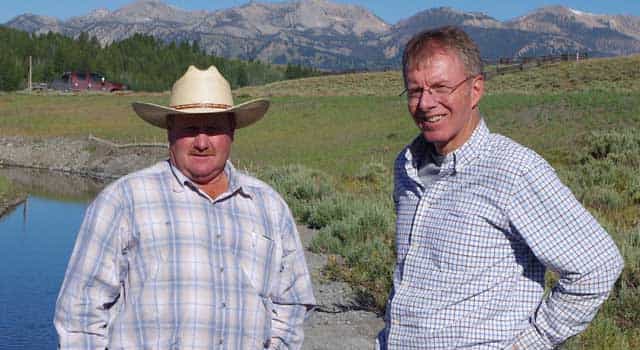
Rancher Mike Henslee, left, with Mark Moulton of the Sawtooth National Recreation Area by the Pole Creek diversion.
But it took clever coordination among the project partners to fund this aspect of the project. The Bureau of Reclamation covered the cost of drilling the test wells and developing one of them into operational status. The second well was developed with NOAA Fisheries Pacific Coast Salmon Recovery Funds through the Idaho Governor’s Office of Species Conservation. The Idaho Water Resource Board is covering the annual cost of the pumping bills for irrigation through its water transactions program, funded by the Bonneville Power Administration. And a new, state-of-the-art, fish-friendly irrigation diversion was put in place on Pole Creek. It was designed and engineered by the Bureau of Reclamation and installed by Idaho Fish and Game.
“We tried to get more water in the creek and keep our pastures and operation going,” Henslee says.
Mark Moulton, Water and Fisheries Program Leader for the Sawtooth NRA, is pleased with the outcome. He was a key player in negotiating water flows not only with the Henslees, but also with federal fish authorities, who had to sign off on the project during the environmental review process.
“I think it’s wonderful. I think it’s great in two respects,” Moulton says. “First, it’s great to find a balance between the natural resources and the multiple uses that occur along Pole Creek. Second, it was quite rewarding to see a whole group of regulatory and partner organizations come together to agree on individual objectives for the project and then run with them, piece by piece, to move the whole comprehensive effort along. It’s a great story!”
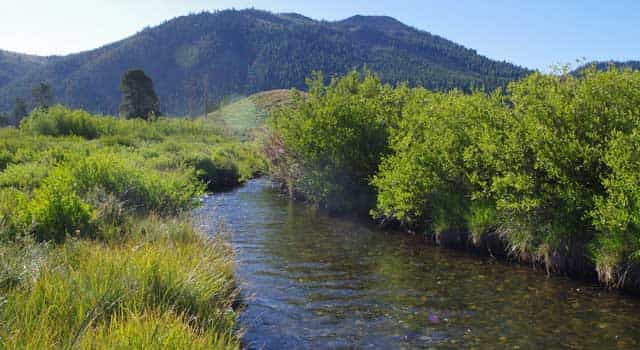
Located near the Salmon River headwaters, Pole Creek was a strategic location for a fish-restoration project, experts say. The stream often has higher flows than the Salmon River itself, and water flows are critical for fish spawning.
Mike Henslee and Mark Moulton started talking about making improvements on Pole Creek years ago. Because the irrigation diversion was on federal land, they knew they’d have to address the need for more stream flow, as well as upgrade the diversion so juvenile and adult fish could move up and down the stream. The old diversion had fish-passage issues, and the special-use permit allowing its operation was due for renewal.
“Because of the situation with the creek, that is, there’s enough water for agriculture or there’s enough for fish, but not enough for both objectives. We knew that was the case here,” Moulton says. “The diversion took the majority of the water during the summer months and there was insufficient water for adults to move in or for juvenile fish.”
With this understanding, an interagency technical group met early in the effort to establish the goals and objectives for the watershed, including streamflow. With this as a guide, in time, the Henslees and Moulton reached agreement on minimum flows for fish. Moulton took that information to NOAA Fisheries and the U.S. Fish and Wildlife Service to obtain their agreement on the new minimum flows for Pole Creek, using charts and graphs to make his case. Historical water flow information for Pole Creek showed that even in drought years, the mini- mum flow could be reached.
Getting conceptual buy-off from the federal agencies early on in the process, before the Forest Service even started the formal environmental review process, made things go smooth. It was an innovative approach in the realm of government affairs and permitting.
“We’ve learned, just engaging them early in the conversation – build the solution together – and then when you get to the other end, and formal consultation needs to occur, you’re already there, they’re already on board with that,” Moulton says.
Going through the environmental permitting process raised the possibility that the project might take years to get approved. Someone could sue the Forest Service to try to stop the project. That made the Henslees nervous.

It took several years of meetings between the Henslees, Custer Soil and Water Conservation District, Sawtooth NRA, NOAA Fisheries, U.S. Fish and Wildlife Service, Bonneville Power Administration, Bureau of Reclmation and other project partners to reach agreement on minimum flows for adult and juvenile Chinook salmon, steelhead and resident fish, among other issues.
“The biggest thing was keeping everyone on board, keeping the ball rolling,” Henslee says. “We had to get through NEPA, that was a big challenge. The environmental community in lower Blaine County, they were concerned. We had to get thru all of those hoops and loops.”
Karma Bragg, project manager for the Custer Soil and Water Conservation District, felt nervous about all of the potential pitfalls as well. The Custer District played an important role in serving as a broker between federal and state agencies and the Henslees throughout the project.
“I think one of the toughest components of doing a project is you start working with landowners and they want it done tomorrow,” Bragg says. “Most of our projects are 1-2 years out to get all the planning done, and this one was double that, if not more.”
Henslee credits the Custer District in keeping things moving forward. “Karma Bragg kept the ball moving and rolling,” he says. “She was very instrumental in leading the charge and getting all the agencies together and keeping them moving.”
As the project proceeded, the Henslees agreed to fence off two miles of Pole Creek, with broad setbacks, to keep cattle away from the stream. The Shoshone-Bannock Tribes worked on that portion of the project, providing the materials and labor to install the fence. The fencing costs were funded by the BPA.
New fish screens were installed next to the fish-friendly diversion to protect juvenile fish as well, built by Idaho Fish and Game in the Fish Screen facility at the Salmon office. “We have moved the fish screen to coincide with the new point of diversion, so they have the most modern technology with the fish screen here,” Davis says. “That helps protect the out-migrating fish from getting entrained in the irrigation ditches.”

A new layout of the Henslee’s pivot sprinklers and irrigated pasture system was designed and executed by the Natural Resources Conservation Service and implemented by the Henslees. The new pivots are super efficient and use less water, leaving more in the stream for fish.
The Henslees also reconfigured their grazing pastures with new fencing. Working with the Natural Resources Conservation Service, they developed 12 off-site watering stations in the various cattle pastures and buried five miles of water pipelines to carry water to the troughs. And they installed new, more efficient pivot sprinklers for irrigating the pastures. Dale Gooby of NRCS explains.
“The old system consisted of five pivots that were energized by hydropower that was diverted from Pole Creek,” he says. “What we did is reconfigured that system with 10 smaller pivots that are more efficient, and brought in grid power in order to make them go around.”
Water from Pole Creek or the wells can be used for irrigation, depending on how much water is in the creek. “These pivots are smaller, more efficient, all designed for 750 gals/minute,” Henslee says. “We tried to get more water in the creek, and keep our pastures and operation going.”
The major redesign of the pasture system was required, in part, because two of the old pivots used to roll through Pole Creek in multiple spots, providing another impact to fish and harming the creek and riparian area. Once the whole stream was fenced off, the pivot and pasture system was reconfigured to irrigate the fields outside of the Pole Creek riparian area. Tearing out all of the old pivots and fencing took a lot of work, Henslee notes.
“That took a lot of time and money,” he says. “The agencies came with a lot of money on the table, but we had to completely revamp it. All of the old pivots had to go down. We had several semi-loads taking them out, the old pipeline was taken out, and all of the old fences got rolled up and torn down.”
They did all of that construction work in one summer. “We just turned this ranch upside down last summer. And it’s really nice to come back and see that it’s healed up,” Bragg says.
Meanwhile, there were fish-passage issues at five road culverts on both private and public land in the Pole Creek project area. All of those were replaced with bridges or passable structures to make them fish-friendly as well.
Also upstream, the Sawtooth NRA addressed other fish issues along Pole Creek on national forest land. Trail bridges were installed in key locations in an existing ATV trail network to allow the closure and rehabilitation of more than 10 fords on Pole Creek. In addition, a mile of the main Pole Creek dirt road was relocated away from the creek to eliminate erosion issues on Forest Service land, and a quarter-mile of Pole Creek was restored to its historic channel upstream of the Henslee property.
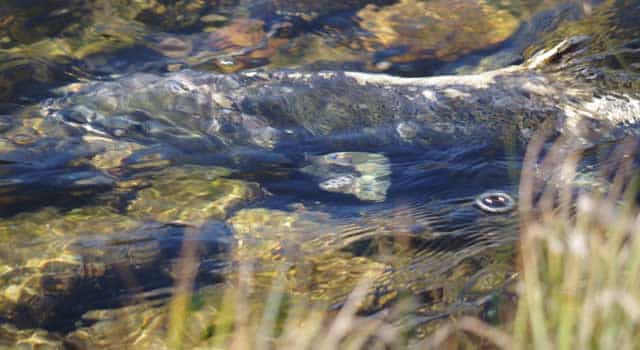
Chinook salmon travel 900 miles from the Sawtooth Valley to the Pacific Ocean through a gauntlet of eight dams, spend 2-3 years in the ocean, and then return to spawn a new generation. The Pole Creek project creates perfect conditions for juvenile and adult Chinook to thrive for many years to come, as well as steelhead and resident fish.
All told, the Pole Creek project cost in excess of $3 million. The Bonneville Power Administration was a major funder to assist with fish habitat improvements through the Columbia River Fish Accords. The Governor’s Office of Species Conservation and the Custer Soil and Water Conservation District were instrumental in setting up partnerships for federal and state funding. Another major funder was the NOAA Fisheries Pacific Coast Salmon Recovery Fund. At least 10 state and federal agencies participated in the project.
In addition, the project transcended the different cultures of Blaine County, home of Sun Valley, where the Saw- tooth NRA headquarters is located and where potential environmental critics and litigants watched the project closely, and Custer County, where ranching, private property rights and the agricultural way of life are highly regarded.
Both Moulton and Bragg hope that a similar collaborative model could be used for future projects. “This project has more partners than any I’ve ever worked on. Everyone did their part,” Bragg says. “But it still comes down to willing landowners and cooperation of all the partners to make this work.”
“I’ve known Mike for many years,” adds Moulton. “I’ve always recognized they are a progressive family. They de- serve tons of credit for being willing to step up to a table full of agency folks. That isn’t an easy thing to do – that took courage and patience and perseverance to stick thru all those bureaucratic processes that have to occur. I’m happy we found that trust. They deserve a lot of the credit for this outcome.”
After all was said and done, the project earned several awards – one from the Idaho Association of Soil Conservation Districts and one from the Forest Service regional office in Ogden, Utah.
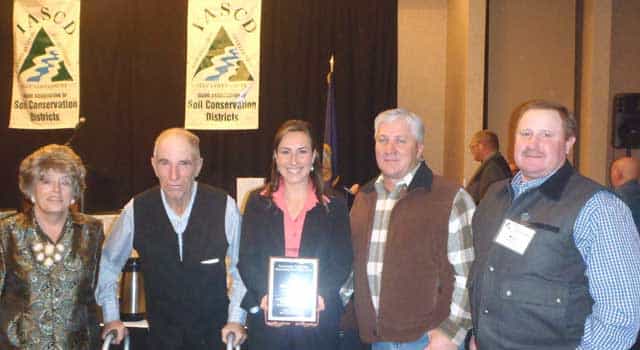
Custer SWCD partners, NRCS officials and Mike Henslee are pictured with an award from the Idaho Association of Soil and Water Conservation Districts. The project also received an award from the Forest Service.
Over time, adult Chinook are expected to swim upriver and spawn in Pole Creek, and juvenile salmon will swim more than 900 miles to the Pacific Ocean before returning two or three years later to spawn a new generation. In a recent IDFG snorkel survey of Pole Creek, they counted 1,600 juvenile fish in the project area. And the Henslee’s fish-friendly irrigation diversion on Forest Service private land was permitted for many years to come.
“This is really the first year that we’re going to see the full implications of the project on the ground, and it might take some time to see the fish respond to the additional flow in-stream,” says Davis of IDFG. “We’re pretty ex- cited to see not only how it benefits Pole Creek but the Salmon River downstream from this point.”
Steve Stuebner is the writer and producer of Life on the Range, an educational project sponsored by the Idaho Rangeland Resource Commission.
© Idaho Rangeland Resources Commission, 2017

